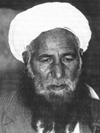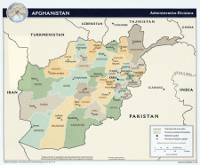During a raid in eastern Afghanistan two days ago, Coalition and Afghanistan special operations forces targeted a leader of the Hizb-i Islami Khalis. The group has links to al Qaeda and the Taliban, and the raid took place in a district of Nangarhar province that has hosted an assortment of terror groups in the past.
A combined Coalition and Afghan force launched an operation in the Khogyani district on Nov. 11. The target of the raid was "a Taliban and Hizb-i Islami Khalis leader," the International Security Assistance Force said in a press release.
"The leader directs Taliban and HIK militants in the district, as well as facilitates the purchase and movement of small arms and IEDs throughout Nangarhar province," ISAF stated.
This is just the second time ISAF has announced that it targeted a Hizb-i Islami Khalis commander. The last raid against an HIK leader took place on March 11, 2011, in Jalalabad in Nangarhar. That HIK commander was described by ISAF as being "affiliated with al Qaeda, and facilitates improvised explosive device, and suicide bomber attacks" [see LWJ report, Raid in Afghan east targets Hizb-i Islami Khalis leader, for more information].
The district of Khogyani is known to serve as a hub for groups linked to both al Qaeda and the Taliban. On Dec. 17, 2010, Coalition and Afghan forces captured a Taliban commander who led forces in the district of Khogyani. The commander "led Taliban attacks on district centers, Afghan national security forces check points and coalition force bases" and commanded "a joint Taliban and Lashkar-e-Islam group." The Lashkar-e-Islam is a Taliban-like group run by Mangal Bagh [for more information, see LWJ report, A profile of Mangal Bagh], who is based in Pakistan's Khyber tribal agency.
On Nov. 19, 2010, ISAF and Afghan forces captured the top suicide operations facilitator for all of Nangarhar province during a raid in the district. The suicide facilitator was "working for Al Qaeda, Taliban, Haqqani [Network] and other insurgent groups," according to ISAF. The commander, who was not named, "moved suicide bombers into Afghanistan" from Pakistan.
And in July 2010, Coalition and Afghan forces captured two Taliban commanders who were "directly linked to the Taliban emir of Khogyani district and assisted with the recent influx of Lashkar-e-Taiba fighters into the province" [for more information, see LWJ report, US military begins to link Afghan Taliban to Pakistani terror groups]. The Lashkar-e-Taiba is a Pakistan-based terror group that is allied with both al Qaeda and Pakistan's military and intelligence service.
Al Qaeda, Hizb-i Islami Khalis, and allied Pakistani terror groups such as Lashkar-e-Taiba, Lashkar-e-Islam, and the Movement of the Taliban in Pakistan all maintain a presence in Nangarhar province, according to an investigation by The Long War Journal. The presence of terror cells has been detected in the districts of Achin, Bati Kowt, Behsud, Chaparhar, Dara Noor, Deh Bala, Hisarak, Jalalabad, Khogyani, Pachir wa Agam, Sherzad, and Shinwar, or 12 of Nangarhar's 22 districts.
Background on the Hizb-i Islami Khalis

|
| Maulvi Mohammed Yunis Khalis, the founder of the Hizb-i Islami Khalis. |
The Hizb-i Islami Khalis was founded in 1979 by Maulvi Mohammed Yunis Khalis, who broke with Hizb-i Islami leader Gulbuddin Hekmatyar to form his own party. Based in the vital eastern province of Nangarhar, which borders Pakistan, HIK was one of the seven major mujahideen groups that battled the Soviets during the 1980s and were collectively known as the Peshawar Seven. Jalaluddin Haqqani, the leader of the Haqqani Network, which is also closely tied to al Qaeda, was one of Khalis' top three commanders.
After the Soviet withdrawal in 1989, Khalis cooperated with the interim government, but then quietly supported the Taliban takeover of the country. Khalis was instrumental in welcoming leader Osama bin Laden to Afghanistan after al Qaeda was ejected from Sudan in 1996. The US government said that Khalis helped Osama bin Laden escape from al Qaeda's stronghold in the Tora Bora mountains during the US operation there in 2001.
Khalis died on July 19, 2006, according to his son, Anwarul Haq Mujahid.
After his father's death, Mujahid took control of the HIK and created a military group known as the Tora Bora Military Front, which operates in Nangarhar and has been behind a series of deadly attacks in the province. Pakistan detained Mujahid in Peshawar in June 2009. Prior to his detention, Muhajid served as the Taliban's shadow governor of Nangarhar.
Mujahid is now out of Pakistani custody. On Feb. 8, Mujahid spoke at the funeral of Awal Gul, a former Guantanamo Bay detainee who was captured by US forces in 2002 and died at the facility of natural causes on Feb. 1 of this year.
